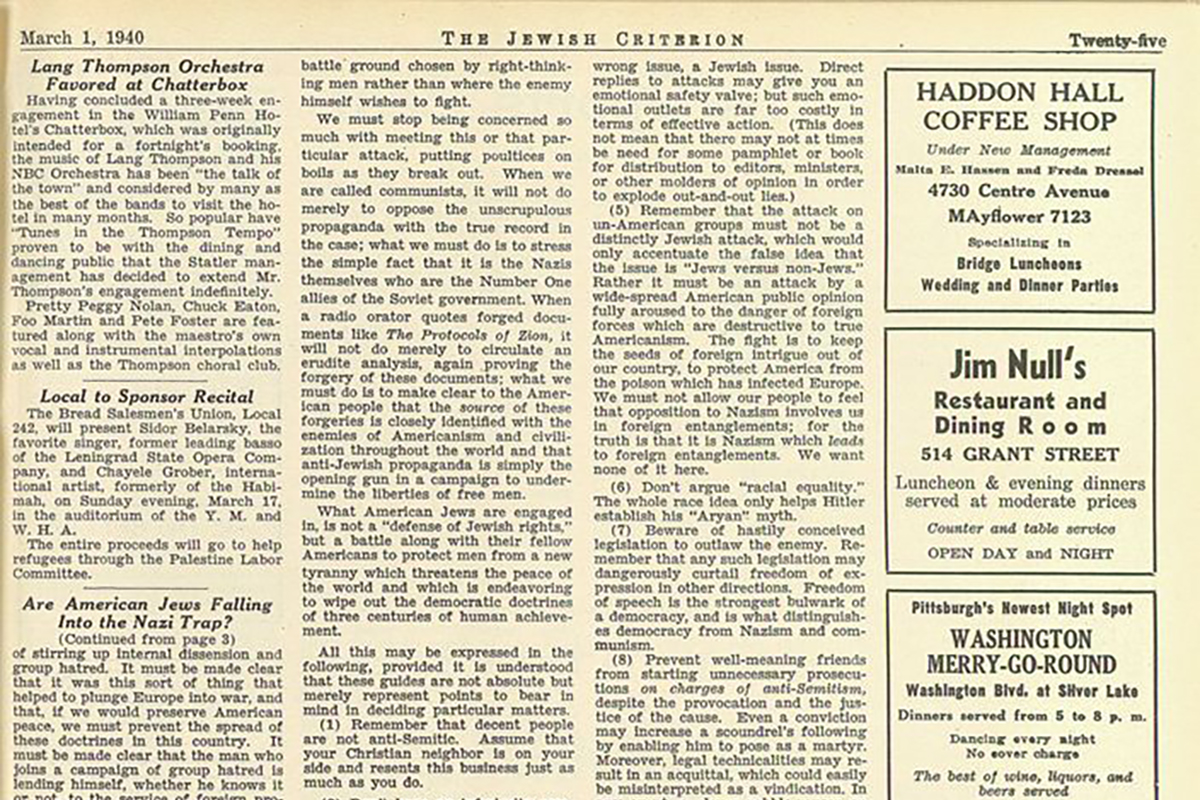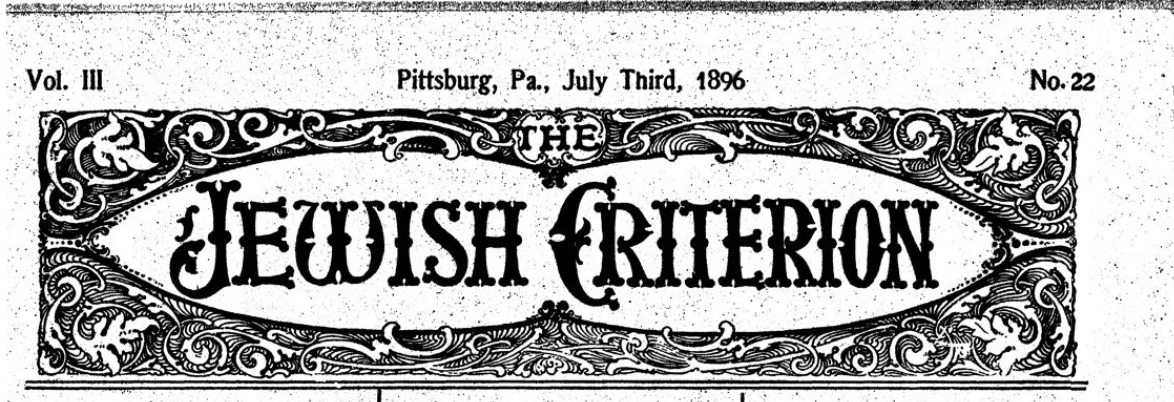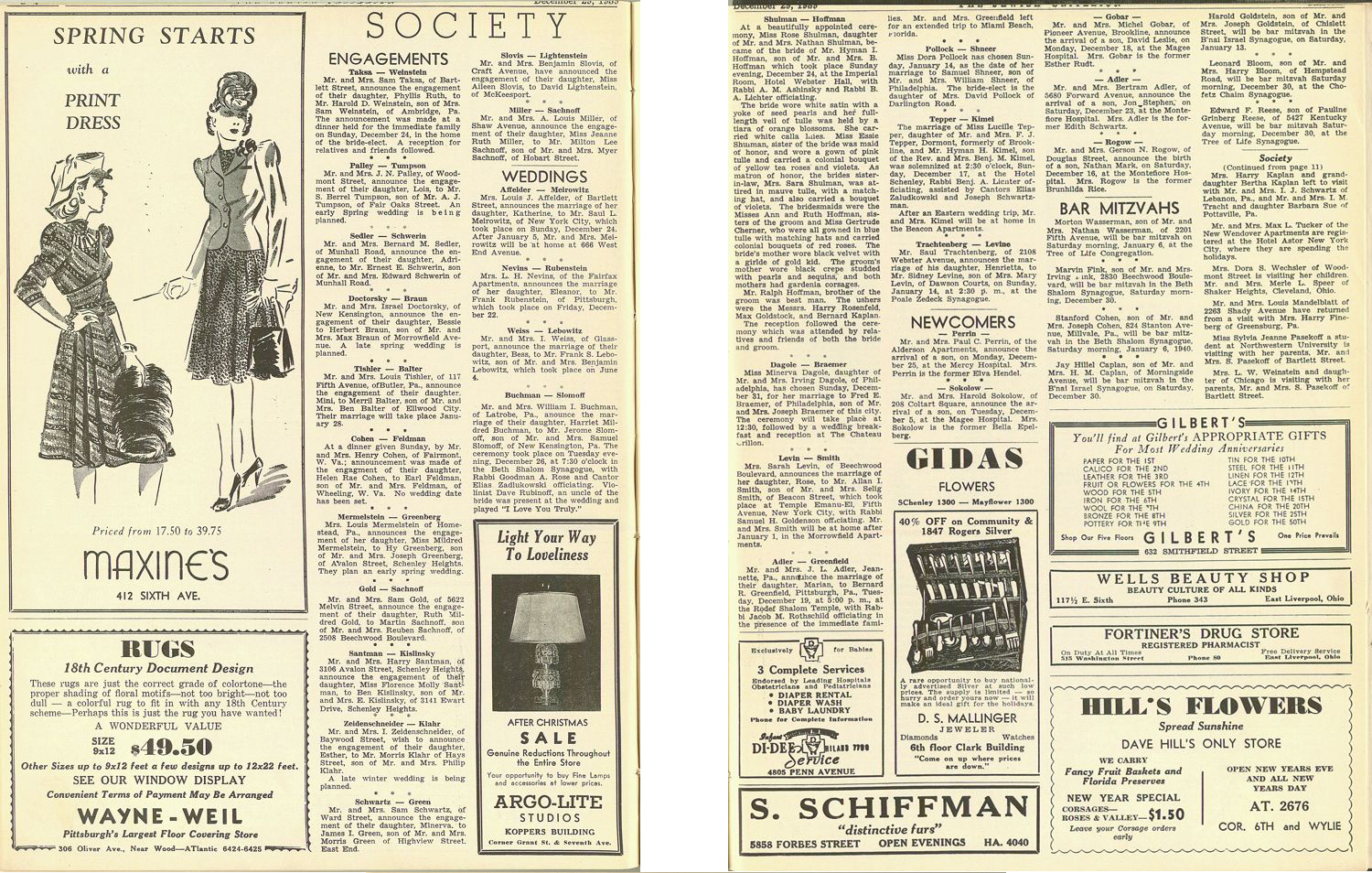The University Libraries’ Role in the Pittsburgh Jewish Newspaper Project

The University Archives is home to more than 100 years of CMU history, with collections containing approximately 5,000 linear feet and 10TB of historic records and materials. As a part of the larger Pittsburgh community, Carnegie Mellon’s past is entwined with the culture and heritage of its neighbors, and some of these collections capture the history of those neighbors as well. The Pittsburgh Jewish Newspapers is one such resource.
The collection contains more than 9,000 digitized and searchable back issues from four local English-language Jewish newspapers: The Jewish Criterion (1895-1962), the American Jewish Outlook (1934-1962), the Jewish Chronicle (1962-2010), and the YM&WHA Weekly, which eventually became the Jewish Community Center News (1926-1976).

These issues contain extensive records of the history of the Pittsburgh Jewish community. In the 1840s Jewish immigrants from Germany established a burial society in Pittsburgh to care for their dead, and by the end of the Civil War the first two congregations, Rodef Shalom and the Tree of Life, had been formed. The number of Jewish people in the area continued to grow with the arrival of Yiddish-speaking Jews from the 1890s until 1920. It was in 1895 that the first English-language Jewish newspaper, the Criterion, was established.
The Pittsburgh Jewish Newspaper Project, which encompasses the effort to gather and digitize the collection, is a collaboration between the Carnegie Mellon University Libraries, the Rodef Shalom Congregation Archives, the Rauh Jewish Archives at the Senator John Heinz History Center, and the Jewish Chronicle of Pittsburgh. Additional materials were loaned by the Carnegie Library of Pittsburgh, and generous financial support has been provided by the Jewish Federation of Greater Pittsburgh, the Philip Chosky Charitable Educational Foundation, and donations to Carnegie Mellon University in memory of Henry Posner, Jr.
The project began in the early 2000s when Anne Molloy, executive director of the Posner Fine Arts Foundation and member of the Libraries Dean’s Advocacy Council and then-chair of the Library and Archives of the Rodef Shalom Congregation, began looking for ways to preserve the Jewish newspapers of Pittsburgh — and to make them more accessible. The documents were in high demand among the community, but were challenging to work with. None had been indexed, so they were difficult to search. In addition, existing collections were incomplete, and fragile original copies were at risk when being handled.
Rodef Shalom Archivist Martha Berg worked frequently with the bound volumes of the Jewish Criterion before the documents were digitized. “I remember getting so many family history reference requests — people asking, ‘Was my great uncle a member of your congregation?’ or ‘Can you find me a specific obituary?’” she said. “But unless someone provided an exact date, I couldn’t usually help them. I only worked part time, and I unfortunately wasn’t able to leaf through every issue to find one little detail.”
Each newspaper issue contained a wide variety of information — company advertisements, social news, international news, fashion, food, births, deaths, weddings, bar and bat mitzvahs. “It was a treasure trove of information that paints a really complete picture of the Jewish community,” Molloy explained. “That paper had everything everyone did — it even listed when people returned home from their summer vacations.”

Because the sheer amount of information was too much to practically index, digitizing was the next logical step. And the University Libraries was the perfect partner for the job.
The Libraries had recently completed another digitization project of a large scale: the Posner Memorial Collection. This project digitized more than 1,000 rare books, and resulted in a staff with experience working with brittle documents, non-invasive scanning equipment, and a dedicated and secure space for the work.
“The project was an enormous undertaking, well outside the capability of the average small nonprofit organization,” said Molloy. “The expertise needed to do the scanning and then make the data accessible was huge, and it was also a challenge to think about maintaining the database over time. Technology is constantly changing, and to maintain a viable resource you have to be able to keep up.”
Each week, another big box of fragile newspapers was taken to the Libraries to be scanned. Some issues were found to be missing, and even existing issues had sections that had been cut out and removed. The Libraries worked to fill in the gaps, turning to other local organizations like the Carnegie Library of Pittsburgh. As work on the Criterion wrapped up, the team moved on to the other newspapers.
The finished project is an invaluable resource for the Jewish community.
“When the project first went up in 2007, it was the largest collection of Jewish newspapers ever digitized and made accessible in the United States — it was pioneering in that regard,” Berg said. “It’s made a huge difference for people who ask me questions about their family history. I can refer them to the resource, and they can find that their great grandmother hosted a card party at her house in 1914. It really contributes to people’s idea of who their ancestors are.”
The full collection has had several homes online over the years, and is now hosted on the Libraries’ Islandora 8 platform. The Libraries was among the first libraries to implement the innovative platform, which allows advanced searching and browsing with the help of metadata.
“CMU Libraries is fulfilling a very critical function here,” Molloy said. “It’s a wonderful way for CMU to support the community, and in my opinion, a gift for the world.”
To view the Pittsburgh Jewish Newspapers, explore the digital collection. You can also contact the Archives to schedule an appointment, or visit during drop-in hours on Thursdays 10:00 a.m. – 4:00 p.m. during the semester (see here for up-to-date hours).
To explore more Jewish history, visit the Violins of Hope exhibit in the Posner Center from October 7 to November 21. The exhibit features string instruments played by Jewish musicians during the Holocaust, and also includes educational and cultural programs spotlighting diversity, perseverance, and the arts.
by Sarah Bender, Communications Coordinator
